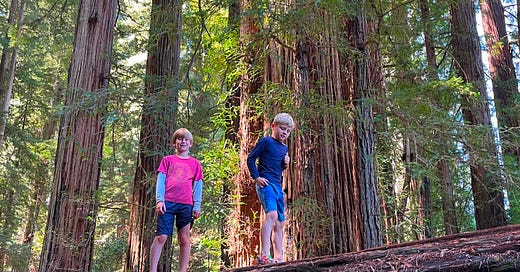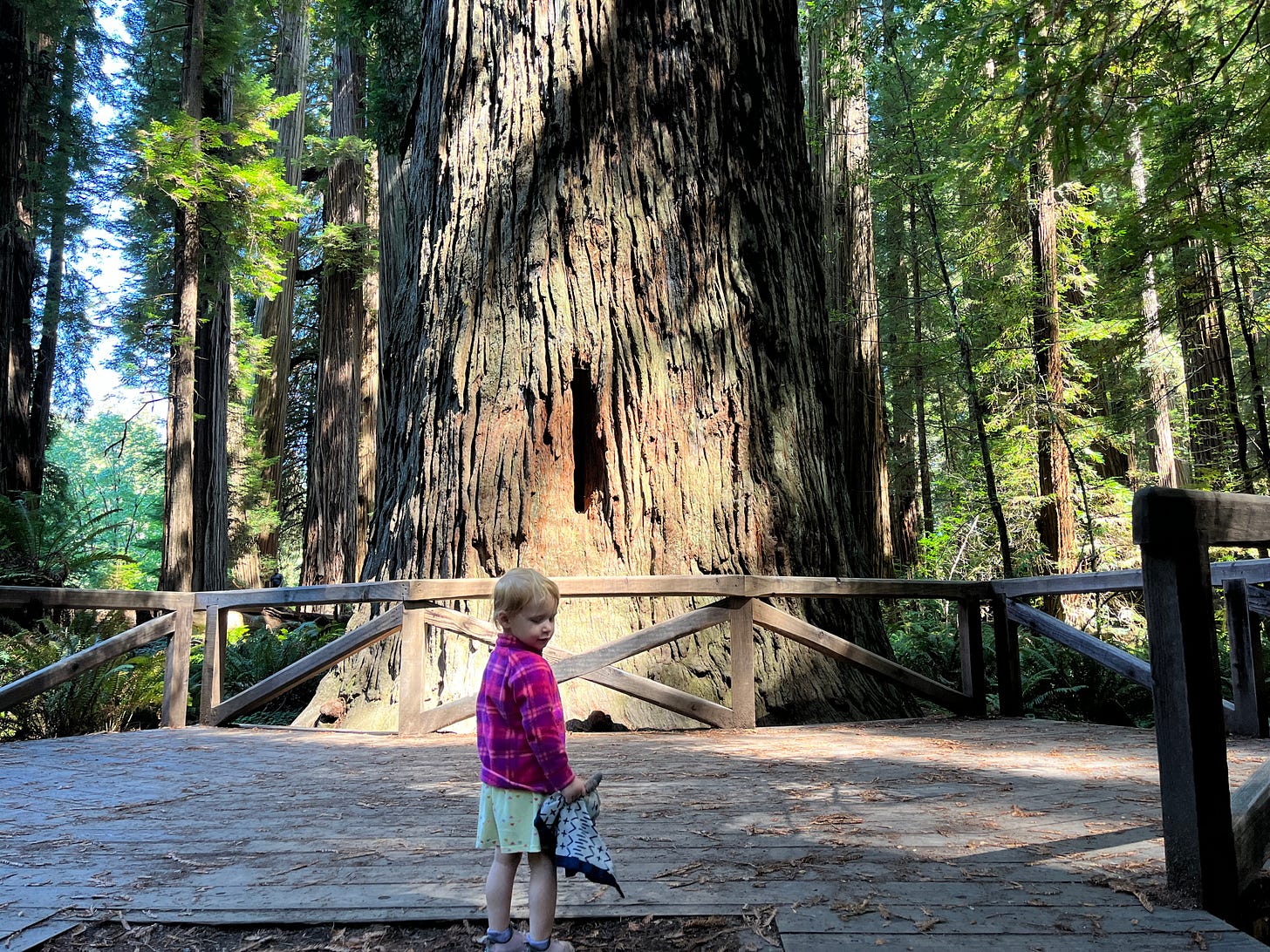From Impossible to Inevitable: Lessons from the Redwoods
A walk through the Redwood forests got me thinking about how there are always forces pushing back against our worst capitalist excesses.
Of all the places we visited on an epic road trip this summer, the Stout Memorial Grove in Northern California was the most magical. Adults craned their necks in search of the canopy some 330 feet above as kids ran from one downed log to another, exploring nature’s playground. Walking amongst thousand year old trees brought a serenity I don’t often experience. It made me want to learn more about the person behind this place.
Before the California Gold Rush, Stout Grove was nothing special. The Redwood forest stretch for more than two million acres from Central California to Southern Oregon. It must have seemed impossibly big and permanent.
But demand for wood followed the people flocking to California; old growth trees became a local and lucrative resource to exploit. By the mid nineteenth century, Indigenous people in the Redwoods were forced from their lands to make way for lumber mills. For example, the Yurok Tribe was removed from its traditional lands, known as ‘O Rew, to make way for the Orick Mill Site. After 200 million years, the majestic Redwoods were at risk of extinction.
Frank D. Stout, originally from Dubuque, Iowa but based in Chicago, was one of the men who profited from all of the logging. He got his start working at a midwestern sawmill that his father owned. Over the decades, he expanded his business interests to include banking, power and electricity, and farming. Sawmills and lumber remained a constant, and he served as the CEO of the California and Oregon (C. & O.) Lumber Company in the early 20th century.
During World War I, the C. & O. Lumber Company harvested Douglas firs and Redwoods from the Smith river area (the location of the Stout Memorial Grove today). The region was inaccessible by inland road—there being a massive old growth forest in the area and all—so the lumber was transported from the mills to market by sea. In 1925, the regional mill shut down, and in 1927, Frank D. Stout died. (Based on the little I was able to learn about him, it seems unlikely that he ever saw the Redwoods).
As Frank D. Stout and others logged the land, a counter-chorus of voices advocating for the preservation the forests rose up. The Gold Rush coincided with the era of Emerson, transcendentalism, Walden Pond, and Alexander von Humboldt (who I wrote about here). In California, Yosemite was first protected in 1864, as its great advocate John Muir hiked its trails and spread the gospel of nature across the country.
The push and pull between capitalism and conservation came together in 1929 when Frank D. Stout’s widow, Clara W. Stout, donated the 44 acres that became the Stout Memorial Grove in honor of her late husband to the Save the Redwoods League, which was established in 1918 to purchase, preserve, protect, and restore the Redwoods. Millions of people have benefited from this small act of generosity, including my family.
Not only did the Save the Redwoods League give us Stout Grove and so many other Redwood forests to explore, it’s trailblazing a new (and very old) approach to conservation: empowering indigenous communities to manage their land. The old Orick Mill Site (‘O Rew) I mentioned above was purchased by the League in 2013. Following a decade of the League partnering with the Yurok Tribe, and National Park Service, and the California Parks to replace the asphalt at the mill site with thousands of native plants, the four organizations signed a first-of-its-kind agreement to return the land to the Yurok Tribe, which will co-manage it with the National Park Service and California State Parks.
This agreement is both a sign of where we’re headed and a reminder of David Treuer’s prescient 2021 cover story for The Atlantic, which argued (correctly) that stewardship of the National Parks should go to the tribes.
Why tell this story?
I do not believe in historical determinism; we live in a non-linear world, where change happens fast and the future is for us to define. Things that seemed impossible in the recent past—like saving the Redwoods—became reality because people worked together with clear-eyed optimism and determination in service of a larger goal.
The thousand year old redwoods we hiked past will remain standing long after anyone remembers my name. But the people who visit and crane their necks to the sky in 2850 will know the name of the Yurok Tribe, because they will still be there, protecting the forest and preserving their culture.





Love this! Have you read the really strange Vanity Fair exposé about the Bohemian Club? https://www.vanityfair.com/culture/2009/05/bohemian-grove200905
Also, if curious, here’s something on the history of my hometown, Moraga. The stand of redwoods that used to be there could be seen from the bay, and ships used it to navigate! Such a loss. https://moragahistory.org/moraga-history/turning-points/
Excellent piece